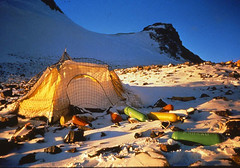2011 Eco-Everest expedition begins, with a mission

Posted April 11, 2011 at 1:34PM
Apa Sherpa has climbed the world’s tallest mountain a record 20 times. The expedition for his 21st began last week, with the simplest of all environmental goals: to pick up the trash.
In an endeavor where the burden of extra weight can mean the difference between life and death, between surviving with your limbs intact or missing, it’s not surprising that until recently the custom was to leave debris such as used oxygen tanks and food containers on the mountain, where they would likely be covered by snow soon enough anyway. But the trash has accumulated over time and, sadly, global warming has meant less snow and more exposure for what was discarded.
According to an article written by expedition organizer Ang Tshering Sherpa and posted on Explorers Web, this is the fourth consecutive year that the Eco Everest Expedition has been conducted:
“The Eco Everest Expedition was organized successfully for three consecutive years (2008, 2009 and 2010) to create international awareness about the impact of Climate Change in the Himalayas and the lives of the mountain communities.
That is why the expedition uses highly successful alternative energy solutions like the parabolic solar cookers, solar energies for lighting and the SteriPENs for water purification and also encourages other expedition teams to use them . . .
“Since 2008 until today Eco Everest Expedition has brought down more than 12,000 kilos of previous expedition garbage and more than 300 kilos of human waste produced by Eco Everest Expedition from Mt. Everest for proper disposal. Also four dead bodies [have been] recovered and brought down from the mountain for a dignified burial and funeral.”
Apa and his team—which includes porters and guides from other expeditions—are planning on making several trips up and down the widely used Southeast Ridge route, reports Nick Vega on the web site The BQB. That is the most heavily trafficked route to the summit. The climbers (not all of whom will attempt the summit) comprise 40 Sherpas and 22 others from the US, India, Brazil, Japan, Spain, Mexico and Switzerland.
 Since Everest was first successfully climbed in 1953, thousands of people have climbed it, leaving behind the empty oxygen bottles, ropes, tents and other garbage that made their journey possible. Nepal has since required climbers to bring down everything they take up the mountain or lose a substantial financial deposit, but debris from past climbs still litters the slopes.
Since Everest was first successfully climbed in 1953, thousands of people have climbed it, leaving behind the empty oxygen bottles, ropes, tents and other garbage that made their journey possible. Nepal has since required climbers to bring down everything they take up the mountain or lose a substantial financial deposit, but debris from past climbs still litters the slopes.
An unsigned Associated Press story reports that the team that left Katmandu on April 6 plans to bring down 8,800 pounds (4,000 kilograms) of garbage from the lower part of the mountain and another 2,200 pounds (1,000 kilograms) from near the 29,035-foot (8,850-meter) summit. "I want to do this for my country, my people and for Everest," said Apa.
Apa first climbed Everest in 1989. More recently, he has campaigned about the degradation he has seen on the Himalayan peaks due to global warming and other issues. He said when he first began climbing Everest, the trail to the summit was covered with ice and snow. Now, it is dotted with bare rocks. The melting ice has also exposed deep crevasses, making expeditions more dangerous.
Apa grew up in the foothills of Everest and began carrying equipment and supplies for trekkers and mountaineers at age 12. He moved to the United States in 2006 and now lives near Salt Lake City.
You can read a first-hand account of last year’s expedition here.
Move your cursor over the images for credit information.
